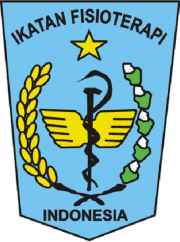Pengaruh Self-Efficacy Pada Treatment Fisioterapi Terhadap Kesembuhan Pasien Pasca Stroke
Wahyuni Wahyuni(1*), Muhammad Farkhan Al Hafidz(2)(1) Fisioterapi FIK UMS
(2)
(*) Corresponding Author
Abstract
Full Text:
PDF (Bahasa Indonesia)References
Aben, L., Heijenbrok-Kal, M. H., Ponds, R. W. H. M., Busschbach, J. J. V., & Ribbers, G. M. (2014). Long-lasting effects of a new memory self-efficacy training for stroke patients: A randomized controlled trial. Neurorehabilitation and Neural Repair, 28(3), 199–206. https://doi.org/10.1177/1545968313478487
Adliyani, Z. O. N. (2015). Pengaruh Perilaku Individu terhadap Hidup Sehat. Perubahan Perilaku Dan Konsep Diri Remaja Yang Sulit Bergaul Setelah Menjalani Pelatihan Keterampilan Sosial, 4(7), 109–114.
Amalia, N. P., & Rahman, M. I. (2021). Latihan Endurance Penderita Pasca Stroke Iskemik. FISIO MU: Physiotherapy Evidences, 3(1), 23–28. https://doi.org/10.23917/fisiomu.v3i1.14351
Ayerbe, L., Ayis, S., Wolfe, C. D. A., & Rudd, A. G. (2013). Natural history, predictors and outcomes of depression after stroke: Systematic review and meta-analysis. British Journal of Psychiatry, 202(1), 14–21. https://doi.org/10.1192/bjp.bp.111.107664
Billinger, S. A., Arena, R., Bernhardt, J., Eng, J. J., Franklin, B. A., Johnson, C. M., Mackay-Lyons, M., Macko, R. F., Mead, G. E., Roth, E. J., Shaughnessy, M., & Tang, A. (2014). Physical activity and exercise recommendations for stroke survivors: A statement for healthcare professionals from the American Heart Association/American Stroke Association. Stroke, 45(8), 2532–2553. https://doi.org/10.1161/STR.0000000000000022
Cho, S. H., & Yun, K. S. (2016). Influence of Uncertainty, Physiologic Risk Factors, Self-efficacy on Self-management in Stroke Patients. Journal of Muscle and Joint Health, 23(2), 114–124. https://doi.org/10.5953/jmjh.2016.23.2.114
Donoso Brown, E. V., & Fichter, R. (2017). Home programs for upper extremity recovery post-stroke: A survey of occupational therapy practitioners. Topics in Stroke Rehabilitation, 24(8), 573–578. https://doi.org/10.1080/10749357.2017.1366013
Ekawati Rahayu Sa’pang, F. A., Linggi, E. B., Kulla, T. L., & Patattan, Z. (2022). Hubungan Self Efficacy dengan Self Management Pada Pasien Post Stroke. Jurnal Ilmiah Kesehatan Sandi Husada, 11, 182–191. https://doi.org/10.35816/jiskh.v11i1.722
Fatmawati, B. R., Suprayitna, M., & Prihatin, K. (2019). Efektifitas Edukasi Basic Life Support dengan Media Audiovisual dan Praktik Terhadap Tingkat Pengetahuan dan Keterampilan Mahasiswa Program Studi Ilmu Keperawatan Jenjang D.III Stikes Yarsi Mataram Tahun 2018. Jurnal Kesehatan Qamarul Huda, 7(1), 6–12. https://doi.org/10.37824/jkqh.v7i1.2019.68
Fernandes, B., Ferreira, M. J., Batista, F., Evangelista, I., Prates, L., & Silveira-sérgio, J. (2015). Task-oriented training and lower limb strengthening to improve balance and function after stroke : A pilot study. European Journal of Physiotherapy, March, 1–7. https://doi.org/10.3109/21679169.2015.1028102
Fink, M. L. (2014). Physical Therapy Journal of Policy , Administration and Health Behaviors of Physical Therapists and Physical Therapist Students in South-central Pennsylvania. 14(4).
Hellström, K., Lindmark, B., Wahlberg, B., & Fugl-Meyer, A. R. (2003). Self-efficacy in relation to impairments and activities of daily living disability in elderly patients with stroke: A prospective investigation. Journal of Rehabilitation Medicine, 35(5), 202–207. https://doi.org/10.1080/16501970310000836
Jones, F., Partridge, C., & Reid, F. (2008). The Stroke Self-Efficacy Questionnaire: Measuring individual confidence in functional performance after stroke. Journal of Clinical Nursing, 17(7B), 244–252. https://doi.org/10.1111/j.1365-2702.2008.02333.x
Omu, O., & Reynolds, F. (2014). Religious faith and self-efficacy among stroke patients in Kuwait: Health professionals’ views. Disability and Rehabilitation, 36(18), 1529–1535. https://doi.org/10.3109/09638288.2014.892641
Pongantung, H., Anita, F., Palango, C., & Manuel, C. (2020). Hubungan Self Efficacy Dengan Quality of Life Pada Pasien Sesudah Stroke. Journal of Islamic Nursing, 5(1), 21. https://doi.org/10.24252/join.v5i1.13894
RI, K. (2018). Riskesdas 2018. Development, 1–220.
Robinson-Smith, G., Johnston, M. V., & Allen, J. (2000). Self-care self-efficacy, quality of life, and depression after stroke. Archives of Physical Medicine and Rehabilitation, 81(4), 460–464. https://doi.org/10.1053/mr.2000.3863
Schmid, A. A., Van Puymbroeck, M., Altenburger, P. A., Dierks, T. A., Miller, K. K., Damush, T. M., & Williams, L. S. (2012). Balance and balance self-efficacy are associated with activity and participation after stroke: A cross-sectional study in people with chronic stroke. Archives of Physical Medicine and Rehabilitation, 93(6), 1101–1107. https://doi.org/10.1016/j.apmr.2012.01.020
Sîrbu, E. (2013). Evaluation of a Home-Based Physical Therapy Program in Ischemic Stroke Patients. Timisoara Physical Education and Rehabilitation Journal, 5(9), 16–23. https://doi.org/10.2478/v10325-012-0002-z
Sriramayanti, C. I., & Darliana, ; Devi. (2018). PENDAHULUAN Stroke merupakan masalah neurologik primer di Amerika Serikat dan di dunia . Stroke penyebab ketiga kematian dengan laju mortilitas 18 % sampai 37 % untuk stroke pertama dan sebesar 62 % untuk stroke selanjutnya ( Smeltzer & Bare , 2002 , p . JIM FKep V, IV(1), 75–86.
Sulistyaningsih, D. R. (2012). Efektivitas Training Efikasi Diri Pada Pasien Penyakit. Training Efikasi Diri, Kepatuhan, Intake Cairan, Penyakit Ginjal Kronik, 50(128), 1–15. http://jurnal.unissula.ac.id/index.php/majalahilmiahsultanagung/article/view/69
Wahyuni, W., & Ajitirtiono, R. (2021). PENGARUH HOME-BASED EXERCISE TERHADAP AKTIFITAS FUNGSIONAL PASCA STROKE: Analisis Kasus Tunggal The Effect Of Home-Based Exercise On Post-Stroke Functional Activities: Single Case Analysis. Jurnal Kesehatan Al-Irsyad, 14(2), 61.
Article Metrics
Abstract view(s): 241 time(s)PDF (Bahasa Indonesia): 308 time(s)
Refbacks
- There are currently no refbacks.







